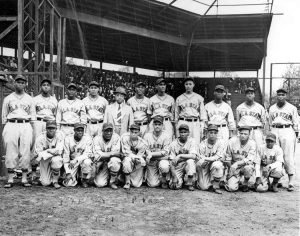

As the team grew and benefited from sponsorships, Hilldale was a part of the first permanent professional leagues: the Midwest-based Negro National League and the Eastern Colored League in 1920. Bolden’s aggressive recruiting tactics allowed the club to capture three ECL pennants, but it was upended by the Kansas City Monarchs in the first Negro League World Series in 1924. Hilldale avenged its World Series loss the next year against the Monarchs.
Bolden built a powerhouse in the Hilldale club, even defeating the Philadelphia A’s five of six games in 1923. The Great Depression, however, was too much to overcome as Bolden left the team in 1930. Hilldale would later disband in 1932.
Bolden returned to the game in 1933, this time with the Philadelphia Stars. Bolden partnered with Ed Gottlieb, who also promoted the Philadelphia Warriors and SPHAS, to provide financial support for the Stars. The Stars played their games in West Philadelphia, first at 48th & Spruce Streets (Passon Field) and then relocating to 44th and Parkside streets (Parkside Field). From the ages identified, the team was composed of many veterans, as the average age was 32.
The best players of the team were the oldest. The Stars were led by Chaney White, who was 40 years old in 1934. In 225 at-bats, White’s slash line read .307/.353/.356. Biz Mackey, a switch hitter, maintained an average over .300 for the season. He was later inducted into the Negro League Hall of Fame in 2006. The most productive player was the second-oldest on the team at age 38. Jud Wilson hit .347/389/.438, was second on the team in home runs with four, and led the team in RBI with 20. To balance the age scale, the Stars’ ace was a 21-year-old who stood at a rail-thin 6-foot, 6-inches and 185 pounds. Slim Jones, a dominant lefty, went 20-5 with a 1.91 ERA and a 0.74 WHIP.
The Philadelphia Stars were winners of the “second half” and played their way into National Negro League Championship against the Chicago American Giants. The Stars, their first year in the league, would secure the championship in a controversial seven-game series. It is important to note the Stars won the series 4-3-1. Chicago took the first three of four on their turf before the series shifted to Philadelphia.
Then, things got wacky. The series was delayed 10 days for unexplained reasons in Philadelphia. When the series resumed, Wilson hit an umpire in game six, which called for immediate ejection. However, the umpire refused to throw out Wilson, much to the dismay of the Giants. The Stars won game six to force a decisive game seven, or so we thought. Game seven was played to a 4-4 tie and was cut short because of darkness. That’s how the game ended, and it forced a decisive game eight. Slim Jones took matters into his own hands, carrying his team to a 2-0 victory for the National Negro League Championship.
To learn more and read source material, check the Philadelphia Encyclopedia. You can also pick up this Philadelphia Stars logo shirt from Shibe Vintage Sports: